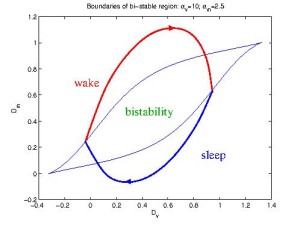 BioDynamics 2013, which took place 11-13 September in Bristol, is the first in a series of annual international workshops designed to bring together biologists, mathematicians, clinicians, physicists, and computer scientists who are interested in dynamical systems in the biological and medical sciences. Gianne attended this workshop and presented joint work with Anne Skeldon and Derk-Jan Dijk (Sleep Research Centre, Surrey) on “Mathematical analysis of human sleep-wake dynamics“. The work was partly funded by EPSRC via the Bridging the Gaps project MiLES.
BioDynamics 2013, which took place 11-13 September in Bristol, is the first in a series of annual international workshops designed to bring together biologists, mathematicians, clinicians, physicists, and computer scientists who are interested in dynamical systems in the biological and medical sciences. Gianne attended this workshop and presented joint work with Anne Skeldon and Derk-Jan Dijk (Sleep Research Centre, Surrey) on “Mathematical analysis of human sleep-wake dynamics“. The work was partly funded by EPSRC via the Bridging the Gaps project MiLES.
Human sleep-wake dynamics are often modelled by multi-oscillator systems. Recent research has shown that wake and sleep can, in part, be characterised by the firing states of different groups of neurones. Two important groups are the ventrolateral preoptic nucleus (VLPO), its neurons fire during sleep, and the monoaminergic (MA) group, which fire during wake. Models that couple these populations of neurones in a mutually inhibitory way and that model the circadian and homeostatic process as a drive that couples to the VLPO have been successful at describing sleep deprivation experiments and the impact of stimulants.
In the talk, a general class of such models was considered, focusing on the roles played by drives on the VLPO and MA in the system and the interplay between these drives and the sleep-wake cycle. Various aspects were discussed such as the intrinsic period and robustness to modelling assumptions on the drives. With no circadian drive present, the relation between the model parameters, the intrinsic period, and time spent asleep can be derived. When the circadian drive acts on the system, a two dimensional system for the homeostatic and circadian drives characterises the sleep-wake cycle. It was shown that the sleep-wake cycle persists if the circadian drive acts on the MA or MA and VLPO, instead of the VLPO only. The talk concluded wiht a short discussion of the relation between various ageing characteristics and the model.
